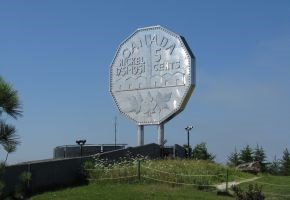BY JANET
GIBSON
There's only one way to describe the Big Nickel.
"It's beautiful," said Christopher Lee Mathieu, a nine-year-old boy from Rouyn Noranda, a city near the western border of Quebec.
Sylvain Mathieu, a mining geologist, said he and his wife Nathalie brought their children to Sudbury last week, telling them, "We're going to visit a mining town where we produce most of the nickel for the world."
About 500 people from all over the world visit Sudbury's earth science centre, Dynamic Earth, each day. While there, most walk up to The Big Nickel, the biggest coin in the world erected in 1964 to recognize the wealth that Sudbury has contributed to the Canadian economy.
"Everybody goes up in the shadow of the nickel," said Jeff Bassett, a Winnipegger who returned to his hometown last week with his girlfriend Chantal Dupasquier.
"I don't even reach the bottom of it," Dupasquier said. "It's definitely one of the biggest icons of Sudbury."
When Canadians were asked about Sudbury, the landmark most talked about was The Big Nickel, said Dynamic Earth director Mia Boiridy.
It's so famous that visitors start looking for it as soon as they pass the city limits.
"I thought it'd be cool if nickels were that big in real life," said Mackenzie Muir, 8, on her third visit.
On the heads side is King George VI, Canada's monarch in 1951. On the tails side is a nickel refinery with a tall smokestack.
And sandwiched in between is a wooden base, Boiridy revealed. She said the giant coin is actually made of stainless steel.
"I think it would take the whole planet to lift it," said Aaron Towle, 10.
Big Nickel Fast Facts:
It's an enlarged replica of the 1951 Canadian nickel. 1751, the
year on the heads side, is when the chemical element nickel was
discovered by Swede Axel Cronstedt.
It's about 64,607,747 times the size of a Canadian nickel.
It weighs close to 13,000 kilograms.
It stands nine metres (30 feet) high.
It's 61 centimetres (24 inches) thick.
Timeline for Canada's five-cent coin:
1922-The first nickel five-cent coins are struck.
1937-The first coins featuring King George VI are released.
1942-Due to the wartime demand for metal, the five-cent coin is
changed from nickel to copper-zinc alloy and is made with 12
sides to distinguish it from the one-cent coin.
1944-The five-cent coin is changed to chrome-plated steel.
1946-The five-cent coin returns to nickel.
1951-Due to the demands on nickel by the Korean War, the
five-cent coin temporarily returns to chrome-plated steel.
1955-The five-cent coin returns to nickel.
2000-The mint produces nickel-plated steel five-cent coins.
2005-The mint releases a circulating five-cent coin
commemorating the 60th anniversary of the end of the Second
World War.
